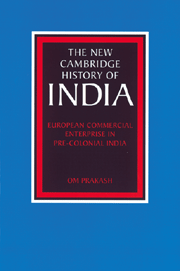Book contents
- Frontmatter
- Dedication
- Contents
- List of figures
- List of maps
- List of tables
- General editor's preface
- Preface
- Introduction
- 1 India in the Indian Ocean trade, circa 1500
- 2 The Portuguese in India, 1500–1640
- 3 The European trading companies: exports from Europe and the generation of purchasing power in Asia
- 4 The companies in India: the politics and the economics of trade
- 5 Euro-Asian and intra-Asian trade: the phase of Dutch domination, 1600–1680
- 6 The VOC and the growing competition by the English and the French, 1680–1740
- 7 The supremacy of the English East India Company, 1740–1800
- 8 European trade and the Indian economy
- 9 Conclusion
- Bibliographic Essay
- Index
- Misc-endmatter
- Map 1 Important trading centres in Asia in the seventeenth and eighteenth centuries"
- Map 2 Portuguese seaborne empire, c. 1580"
- Map 3 The Indian Ocean in the seventeenth and eighteenth centuries, showing the settlements of the English East India Company and of other European nations"
- Map 4 India: main textile–weaving areas, 1600–1750"
- References
6 - The VOC and the growing competition by the English and the French, 1680–1740
Published online by Cambridge University Press: 28 March 2008
- Frontmatter
- Dedication
- Contents
- List of figures
- List of maps
- List of tables
- General editor's preface
- Preface
- Introduction
- 1 India in the Indian Ocean trade, circa 1500
- 2 The Portuguese in India, 1500–1640
- 3 The European trading companies: exports from Europe and the generation of purchasing power in Asia
- 4 The companies in India: the politics and the economics of trade
- 5 Euro-Asian and intra-Asian trade: the phase of Dutch domination, 1600–1680
- 6 The VOC and the growing competition by the English and the French, 1680–1740
- 7 The supremacy of the English East India Company, 1740–1800
- 8 European trade and the Indian economy
- 9 Conclusion
- Bibliographic Essay
- Index
- Misc-endmatter
- Map 1 Important trading centres in Asia in the seventeenth and eighteenth centuries"
- Map 2 Portuguese seaborne empire, c. 1580"
- Map 3 The Indian Ocean in the seventeenth and eighteenth centuries, showing the settlements of the English East India Company and of other European nations"
- Map 4 India: main textile–weaving areas, 1600–1750"
- References
Summary
The last two decades of the seventeenth and the early part of the eighteenth century marked a major qualitative change in the Dutch East India Company's trade between Asia and Europe. The value of this trade continued to grow at a fairly impressive rate. Thus the triennium total of the Company's imports into Europe went up from f.10.79 million during 1668–70 to f.15 million during 1698–1700, and further to f.19.25 million during 1738–40. But more importantly, over the same period, the composition of the imports altered dramatically. Thus between 1668–70 and 1698–1700, the share of pepper and other spices in the total imports came down from 43 per cent to 23 per cent. By 1738–40, this figure had further come down to a mere 14 per cent (Table 4.1). Because of an almost revolutionary change in European fashions, the share of textiles and raw silk, on the other hand, increased significantly. While during 1668–70 these two items together had accounted for 36 per cent of the total imports from Asia, by 1698–1700 the figure had gone up to an impressive 55 per cent. During 1738–40, it stood at 41 per cent. An overwhelming proportion of the Asian textiles and raw silk was procured in India. Thus out of textiles worth f.2.35 million that reached Holland in 1697, for example, those originating in India accounted for as much as 88 per cent. Again, of the Asian raw silk sold in Amsterdam between 1693 and 1720, Indian raw silk accounted, valuewise, for as much as 90 per cent.
Keywords
- Type
- Chapter
- Information
- European Commercial Enterprise in Pre-Colonial India , pp. 211 - 267Publisher: Cambridge University PressPrint publication year: 1998



